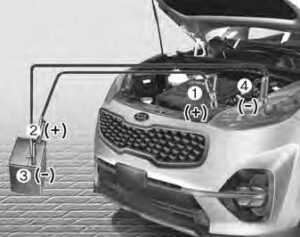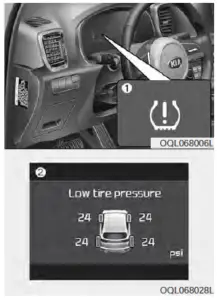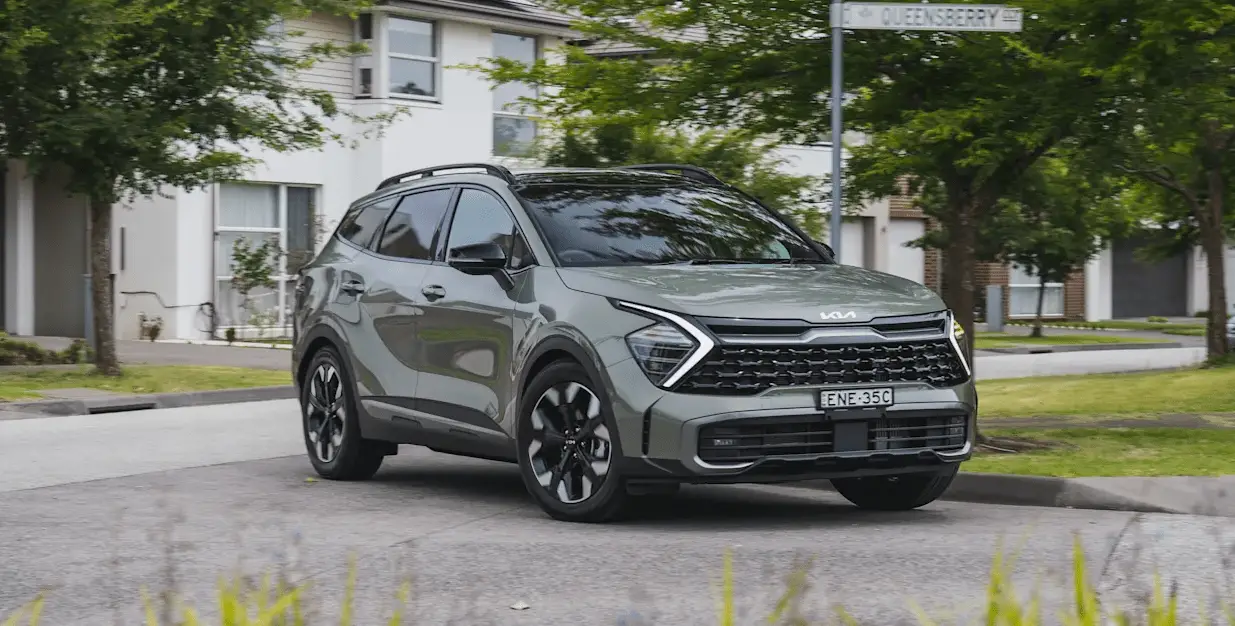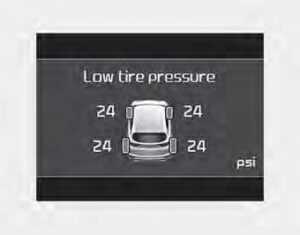Kia Sportage 2022 Emergency Starting, Engine Overheats, and Tire Pressure Monitoring System
The 2022 Kia Sportage has a number of emergency starting and engine overheating measures to help it deal with unforeseen road obstacles. Drivers may use standard jumper cables to jump-start a car with a dead battery, and the Sportage offers safe instructions on how to handle an overheating engine—it’s crucial to cool the engine down before doing more inspections. Furthermore, by consistently checking tyre pressure levels, warning drivers of possible problems, and encouraging safe driving by maintaining appropriate tyre inflation, the Tyre Pressure Monitoring System (TPMS) guarantees the best possible condition of tyres. When combined, these attributes highlight Kia’s dedication to road safety, preparedness, and comfort for drivers.
2023 KIA SPORTAGE Specs, Price, Features and Mileage (Brochure)
Emergency starting

Connect cables in numerical order and disconnect in reverse order.
Jump starting
Jump starting can be dangerous if done incorrectly. Therefore, to avoid harm to yourself or damage to your vehicle or battery, follow these jump-starting procedures. If in doubt, we strongly recommend that you have a competent technician or towing service jump-start your vehicle.
Push/pull start to 12 Volt Battery
Use only a 12-volt jumper system. You can damage a 12-volt starting motor, ignition system, and other electrical parts beyond repair by use of a 24-volt power supply (either two 12-volt batteries in series or a 24-volt motor generator set).
Battery
Never attempt to check the electrolyte level of the battery as this may cause the battery to rupture or explode.
Frozen batteries
Do not attempt to jump-start the vehicle if the discharged battery is frozen or if the electrolyte level is low as the battery may rupture or explode.
Battery
Keep all flames or sparks away from the battery. The battery produces hydrogen gas which will explode if exposed to flame or sparks.
Sulfuric acid risk
When jump-starting your vehicle, be careful not to get acid on yourself, your clothing, or on the vehicle. Automobile batteries contain sulfuric acid. This is poisonous and highly corrosive.
Jump starting procedure
- Make sure the booster battery is 2- volts and that its negative terminal is grounded.
- If the booster battery is in another vehicle, do not allow the vehicles to come in contact.
- Turn off all unnecessary electrical loads.
- Connect the jumper cables in the exact sequence shown in the illustration. First, connect one end of a jumper cable to the positive terminal of the discharged battery (1), then connect the other end to the positive terminal of the booster battery (2).
- Proceed to connect one end of the other jumper cable to the negative terminal of the booster battery (3), then the other end to a solid, stationary, metallic point (for example, the engine lifting bracket) away from the battery (4). Do not connect it to or near any part that moves when the engine is cranked.
- Do not allow the jumper cables to contact anything except the correct battery terminals or the correct ground. Do not lean over the battery when making connections.
Battery cables
Do not connect the jumper cable from the negative terminal of the booster battery to the negative terminal of the discharged battery. This can cause the discharged battery to overheat and crack, releasing battery acid.
- Make sure to connect one end of the jumper cable to the negative terminal of the booster battery, and the other end to a metallic point, far away from the battery.
- Start the engine of the vehicle with the booster battery and let it run at 2,000 rpm, then start the engine of the vehicle with the discharged battery.
If the cause of your battery discharging is not apparent, you should have your vehicle checked by an authorized Kia dealer.
Tow starting vehicle
Never tow a vehicle to start it. When the engine starts, the vehicle can suddenly surge forward and could cause a collision with the tow vehicle.
IF THE ENGINE OVERHEATS
If your temperature gauge indicates overheating, you experience a loss of power, or hear loud pinging or knocking, the engine will probably be too hot. If this happens, you should:
- Pull off the road and stop as soon as it is safe to do so.
- Place the shift lever in P (for Automatic transmission) and set the parking brake. If the air conditioning is on, turn it off.
- If engine coolant is running out under the vehicle or steam is coming out from underneath the hood, stop the engine. Do not open the hood until the coolant has stopped running or the steaming has stopped. If there is no visible loss of engine coolant and no steam, leave the engine running and check to be sure the engine cooling fan is operating. If the fan is not running, turn the engine off.
- Check to see if the water pump drive belt is missing. If it is not missing, check to see that it is tight. If the drive belt seems to be satisfactory, check for coolant leaking from the radiator, hoses or under the vehicle. (If the air conditioning had been in use, it is normal for cold water to be draining from it when you stop).
Under the hood
While the engine is running, keep hair, hands, and clothing away from moving parts such as the fan and drive belts to prevent injury.
- If the water pump drive belt is broken or engine coolant is leaking out, stop the engine immediately and call the nearest authorized Kia dealer for assistance.
Radiator cap
Do not remove the radiator cap when the engine is hot. This may result in coolant being blown out of the opening and cause serious burns.
- If you cannot find the cause of the overheating, wait until the engine temperature has returned to normal. If the coolant has been lost, carefully add coolant to the reservoir to bring the fluid level in the reservoir up to the halfway mark.
- Proceed with caution, keeping alert for further signs of overheating. If overheating happens again, call an authorized Kia dealer for assistance.
Serious loss of coolant indicates there is a leak in the cooling system and this should be checked as soon as possible by an authorized Kia dealer.
Tire Pressure Monitoring System (TPMS)

- R ow tire pressure telltale /TPMS malfunction indicator
- Low tire pressure position telltale (Shown on the LCD display)
Check tire pressure
- You can check the tire pressure in the information mode on the cluster.
- Refer to “User settings mode” in Chapter 4.
- Tire pressure is displayed 1~2 minutes later after driving.
- If tire pressure is not displayed when the vehicle is stopped, the “Drive to display” message displays. After driving, check the tire pressure.
- You can change the tire pressure unit in the user settings mode on the instrument cluster.
- psi, kpa, bar (Refer to “User set-tings mode” in chapter 4).
NOTICE
The tire pressure may change due to factors such as parking conditions, driving style, and altitude above sea level. A low tire pressure warning may sound when a tire’s pressure unit is equal to or higher than nearby tires. This is a normal occurrence, which is due to the change in tire pressure along with tire temperature. The tire pressure shown on the dashboard may differ from the tire pressure measured by a tire pressure gauge.
Each tire, including the spare (if provided), should be checked monthly when cold and inflated to the inflation pressure recommended by the vehicle manufacturer on the vehicle placard or tire inflation pressure label. (If your vehicle has tires of a different size than the size indicated on the vehicle placard or tire inflation pressure label, you should determine the proper tire inflation pressure for those tires.) As an added safety feature, your vehicle has been equipped with a tire pressure monitoring system (TPMS) that illuminates a low tire pressure telltale when one or more of your tires is significantly under-inflated. Accordingly, when the low tire pressure telltale illuminates, you should stop and check your tires as soon as possible, and inflate them to the proper pressure. Driving on a significantly under-inflated tire causes the tire to overheat and can lead to tire failure. Under-inflation also reduces fuel efficiency and tire tread life and may affect the vehicle’s handling and stopping ability. Please note that the TPMS is not a substitute for proper tire maintenance, and it is the driver’s responsibility to maintain correct tire pressure, even if under-inflation has not reached the level to trigger illumination of the TPMS low tire pressure telltale. Your vehicle has also been equipped with a TPMS malfunction indicator to indicate when the system is not operating properly. The TPMS malfunction indicator is combined with the low tire pressure telltale. When the system detects a malfunction, the telltale will flash for approximately one minute and then remain continuously illuminated. This sequence will continue upon subsequent vehicle start-ups as long as the malfunction exists. When the malfunction indicator is illuminated, the system may not be able to detect or signal low tire pressure as intended. TPMS malfunctions may occur for a variety of reasons, including the installation of replacement or alternate tires or wheels on the vehicle that prevent the TPMS from functioning properly. Always check the TPMS malfunction telltale after replacing one or more tires or wheels on your vehicle to ensure that the replacement or alternate tires and wheels allow the TPMS to continue to function properly.
NOTICE
If the TPMS, Low Tire Pressure indicator does not illuminate for 3 seconds when the ignition switch or the Engine start/stop button is turned to the ON position, or if they remain illuminated after coming on for approximately 3 seconds, take your vehicle to your nearest authorized Kia dealer and have the system checked.
Low tire pressure telltale
Low tire pressure position telltale
When the tire pressure monitoring system warning indicators are illuminated, one or more of your tires are significantly under-inflated. If the telltale illuminates, immediately reduce your speed, avoid hard cornering, and anticipate increased stopping distances. You should stop and check your tires as soon as possible. Inflate the tires to the proper pressure as indicated on the vehicle’s placard or tire inflation pressure label located on the driver’s side center pillar outer panel. If you cannot reach a service station or if the tire cannot hold the newly added air, replace the low-pressure tire with the spare tire. Then the TPMS malfunction indicator and the Low Tire Pressure telltale may turn on and illuminate after restarting and about 20 minutes of continuous driving before you have the low-pressure tire repaired and replaced on the vehicle. In winter or cold weather, the low tire pressure may be illuminated if the tire pressure is adjusted to the recommended tire inflation pressure in warm weather. It does not mean your TPMS is malfunctioning because the decreased temperature leads to a proportional lowering of tire pressure. When you drive your vehicle from a warm area to a cold area or from a cold area to a warm area, or the outside temperature is greatly higher or lower, you should check the tire inflation pressure and adjust the tires to the recommended tire inflation pressure. When filling tires with more air, conditions to turn off the low tire pressure telltale may not be met. This is because a tire inflator has a margin of error in performance. The low tire pressure telltale will be turned off if the tire pressure is above the recommended tire inflation pressure.
Low-pressure damage
Do not drive on low-pressure tires. Significantly low tire pressure can cause the tires to overheat and fail making the vehicle unstable and resulting in increased braking distances and a loss of vehicle control.
TPMS (Tire Pressure Monitoring System) malfunction indicator
The low tire pressure telltale will illuminate after it blinks for approximately one minute when there is a problem with the Tire Pressure Monitoring System. If the system is able to correctly detect an underinflation warning at the same time as system failure then it will illuminate both the TPMS malfunction and low tire pressure position telltales e.g. if the Front Left sensor fails, the TPMS malfunction indicator illuminates, but if the Front Right, Rear Left, or Rear Right tire is under-inflated, the low tire pressure position telltales may illuminate together with the TPMS malfunction indicator. Have the system checked by an authorized Kia dealer as soon as possible to determine the cause of the problem. The TPMS malfunction indicator may be illuminated if the vehicle is moving around electric power supply cables or radio transmitters such as at police stations, government and public offices, broadcasting stations, military installations, airports, or transmitting towers, etc. This can interfere with the normal operation of the Tire Pressure Monitoring System (TPMS). The TPMS malfunction indicator may be illuminated if snow chains are used or some separate electronic devices such as notebook computer, mobile charger, remote starter or navigation, etc., are used in the vehicle. This can interfere with the normal operation of the Tire Pressure Monitoring System (TPMS).
Changing a tire with TPMS
If you have a flat tire, the Low Tire Pressure telltale will come on. Have the flat tire repaired by an authorized Kia dealer as soon as possible or replace the flat tire with a spare tire.
Repair Agents
Never use a puncture-repairing agent not approved by Kia to repair and/or inflate a low-pressure tire. The sealant not approved by Kia may damage the tire pressure sensor.
Each wheel is equipped with a tire pressure sensor mounted inside the tire behind the valve stem. You must use TPMS-specific wheels. It is recommended that you always have your tires serviced by an authorized Kia dealer. Even if you replace the low-pressure tire with the spare tire, the Low Tire Pressure telltale will remain on until the low-pressure tire is repaired and placed on the vehicle. After you replace the low-pressure tire with the spare tire, the TPMS malfunction indicator may illuminate after a few minutes because the TPMS sensor mounted on the spare wheel is not initiated. Once the low-pressure tire is inflated again to the recommended pressure and installed on the vehicle or the TPMS sensor mounted on the replaced spare wheel is initiated by an authorized Kia dealer, the TPMS malfunction indicator and the low tire pressure telltale will turn off within a few minutes of driving. If the indicator has not disappeared after a few minutes of driving, please visit an authorized Kia dealer. If an original mounted tire is replaced with the spare tire, the TPMS sensor on the replaced spare wheel should be initiated and the TPMS sensor on the original mounted wheel should be deactivated. If the TPMS sensor on the original mounted wheel located in the spare tire carrier still activates, the tire pressure monitoring system may not operate properly.
Have the tires with TPMS serviced or replaced by an authorized Kia dealer?
You may not be able to identify a low tire by simply looking at it. Always use a good quality tire pressure gauge to measure the tire’s inflation pressure. Please note that a tire that is hot (from being driven) will have a higher pressure measurement than a tire that is cold (from sitting stationary for at least 3 hours and driving less than 1 mile (1.6 km) during that 3-hour period). Allow the tire to cool before measuring the inflation pressure. Always be sure the tire is cold before inflating to the recommended pressure. A cold tire means the vehicle has been sitting for 3 hours and driven for less than 1 mile (1.6 km) in that 3-hour period. Never use tire sealant if your vehicle is equipped with a Tire Pressure Monitoring System. The liquid sealant can damage the tire pressure sensors.
- The TPMS cannot alert you to severe and sudden tire damage caused by external factors such as nails or road debris.
- If you feel any vehicle instability, immediately take your foot off the accelerator, apply the brakes gradually and with light force, and slowly move to a safe position off the road.
Protecting TPMS
Tampering with, modifying, or disabling the Tire Pressure Monitoring System (TPMS) components may interfere with the system’s ability to warn the driver of low tire pressure conditions and/or TPMS malfunctions. Tampering with, modifying, or disabling the Tire Pressure Monitoring System (TPMS) components may void the warranty for that portion of the vehicle.
This device complies with Part 15 of the FCC rules.
Operation is subject to the following two conditions:
- This device may not cause harmful interference, and
- This device must accept any interference received, including interference that may cause undesired operation.
FAQ
To jump-start the Sportage, you’ll need jumper cables and another vehicle with a charged battery. Connect the cables, start the assisting vehicle, and allow the dead battery to charge before attempting to start the Sportage.
The Sportage typically does not have a built-in jump-start feature. You would need external assistance for jump-starting.
If the engine overheats, pull over to a safe location, turn off the engine, and wait for it to cool down. Do not attempt to open the radiator cap while the engine is hot. Check coolant levels and inspect for leaks once it has cooled.
Yes, the Sportage typically has a temperature warning indicator on the instrument cluster that alerts you if the engine begins to overheat.
The TPMS typically uses sensors in each tire to monitor tire pressure. If it detects low pressure in any tire, it alerts the driver with a warning light on the dashboard.
While the TPMS is a valuable tool, it’s not a replacement for regular manual tire pressure checks, as it may not provide real-time pressure updates and can’t detect slow leaks.
The ability to recalibrate or reset the TPMS may depend on the specific model and trim level. Consult the owner’s manual for instructions or contact a Kia dealership for assistance.
It’s a good practice to check the tire pressure at least once a month and before long trips. Cold weather can cause tire pressure to drop, so more frequent checks in winter may be beneficial.
The recommended tire pressure can vary depending on factors like tire size and load. You can find the recommended pressure in the owner’s manual or on a sticker inside the driver’s door jamb.
Most 2022 Kia Sportage models typically come equipped with a spare tire, but it’s essential to verify the specific trim and equipment of your vehicle.
Some Kia models offer run-flat tires as an option, but it’s advisable to check the availability for the 2022 Sportage based on the trim level.
If you get a flat tire, pull over to a safe location, change the flat tire with the spare, and have the damaged tire repaired or replaced as soon as possible.
Yes, temperature changes can affect tire pressure, which, in turn, may trigger TPMS warnings. Cold weather can cause tire pressure to drop, while warm weather can lead to increased pressure.
Tire rotations or changes should not affect the TPMS as long as the sensors are properly installed and calibrated during the service.
The TPMS typically does not require regular maintenance other than checking and maintaining proper tire pressure. Ensure the sensors are not damaged during tire changes or maintenance.
Useful Link
View Full User Guide: Kia Sportage 2022 User Guide
Download Manuals: https://owners.kia.com/content/owners/en/manuals.html
2023 KIA SPORTAGE Specs, Price, Features and Mileage (Brochure)



